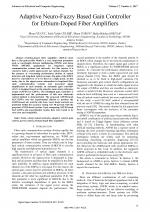| 1/2017 - 3 |
Adaptive Neuro-Fuzzy Based Gain Controller for Erbium-Doped Fiber AmplifiersYUCEL, M. |
| View the paper record and citations in |
| Click to see author's profile in |
| Download PDF |
Author keywords
fuzzy neural networks, adaptive control, gain control, power control, erbium-doped fiber amplifiers
References keywords
fuzzy(22), optical(16), gain(16), edfa(11), celebi(10), systems(9), inference(9), control(9), anfis(9), adaptive(9)
Blue keywords are present in both the references section and the paper title.
About this article
Date of Publication: 2017-02-28
Volume 17, Issue 1, Year 2017, On page(s): 15 - 20
ISSN: 1582-7445, e-ISSN: 1844-7600
Digital Object Identifier: 10.4316/AECE.2017.01003
Web of Science Accession Number: 000396335900003
SCOPUS ID: 85014152564
Abstract
Erbium-doped fiber amplifiers (EDFA) must have a flat gain profile which is a very important parameter such as wavelength division multiplexing (WDM) and dense WDM (DWDM) applications for long-haul optical communication systems and networks. For this reason, it is crucial to hold a stable signal power per optical channel. For the purpose of overcoming performance decline of optical networks and long-haul optical systems, the gain of the EDFA must be controlled for it to be fixed at a high speed. In this study, due to the signal power attenuation in long-haul fiber optic communication systems and non-equal signal amplification in each channel, an automatic gain controller (AGC) is designed based on the adaptive neuro-fuzzy inference system (ANFIS) for EDFAs. The intelligent gain controller is implemented and the performance of this new electronic control method is demonstrated. The proposed ANFIS-based AGC-EDFA uses the experimental dataset to produce the ANFIS-based sets and the rule base. Laser diode currents are predicted within the accuracy rating over 98 percent with the proposed ANFIS-based system. Upon comparing ANFIS-based AGC-EDFA and experimental results, they were found to be very close and compatible. |
| References | | | Cited By |
Web of Science® Times Cited: 4 [View]
View record in Web of Science® [View]
View Related Records® [View]
Updated today
SCOPUS® Times Cited: 6
View record in SCOPUS® [Free preview]
View citations in SCOPUS® [Free preview]
[1] Lifetime Prediction for a Cell-on-Board (COB) Light Source Based on the Adaptive Neuro-Fuzzy Inference System (ANFIS), Kıyak, İsmail, Gökmen, Gökhan, Koçyiğit, Gökhan, Karimi-Maleh, Hassan, Journal of Nanomaterials, ISSN 1687-4129, Issue , 2021.
Digital Object Identifier: 10.1155/2021/6681335 [CrossRef]
[2] New neuro-fuzzy system-based holey polymer fibers drawing process, Mohammed Salim, Omar Nameer, AIP Advances, ISSN 2158-3226, Issue 10, Volume 7, 2017.
Digital Object Identifier: 10.1063/1.4998270 [CrossRef]
[3] The design and implementation of a software based gain control for EDFAs used in long-haul optical networks, Akcesme, Ozcan, Yucel, Murat, Burunkaya, Mustafa, Optik, ISSN 0030-4026, Issue , 2021.
Digital Object Identifier: 10.1016/j.ijleo.2021.166850 [CrossRef]
[4] Estimating Average Power of Welding Process With Emitted Noises Based on Adaptive Neuro Fuzzy Inference System, Gokmen, Gokhan, Akinci, Tahir Cetin, Kocyigit, Gokhan, Kiyak, Ismail, Akbas, M. Ilhan, IEEE Access, ISSN 2169-3536, Issue , 2023.
Digital Object Identifier: 10.1109/ACCESS.2023.3268525 [CrossRef]
[5] Gain Flattening of Three-stage Erbium-doped Fiber Amplifier Based on GFF+VOA, Yu, Miao, Sun, Dong, 2023 IEEE 5th Eurasia Conference on IOT, Communication and Engineering (ECICE), ISBN 979-8-3503-1469-4, 2023.
Digital Object Identifier: 10.1109/ECICE59523.2023.10383015 [CrossRef]
Disclaimer: All information displayed above was retrieved by using remote connections to respective databases. For the best user experience, we update all data by using background processes, and use caches in order to reduce the load on the servers we retrieve the information from. As we have no control on the availability of the database servers and sometimes the Internet connectivity may be affected, we do not guarantee the information is correct or complete. For the most accurate data, please always consult the database sites directly. Some external links require authentication or an institutional subscription.
Web of Science® is a registered trademark of Clarivate Analytics, Scopus® is a registered trademark of Elsevier B.V., other product names, company names, brand names, trademarks and logos are the property of their respective owners.
Faculty of Electrical Engineering and Computer Science
Stefan cel Mare University of Suceava, Romania
All rights reserved: Advances in Electrical and Computer Engineering is a registered trademark of the Stefan cel Mare University of Suceava. No part of this publication may be reproduced, stored in a retrieval system, photocopied, recorded or archived, without the written permission from the Editor. When authors submit their papers for publication, they agree that the copyright for their article be transferred to the Faculty of Electrical Engineering and Computer Science, Stefan cel Mare University of Suceava, Romania, if and only if the articles are accepted for publication. The copyright covers the exclusive rights to reproduce and distribute the article, including reprints and translations.
Permission for other use: The copyright owner's consent does not extend to copying for general distribution, for promotion, for creating new works, or for resale. Specific written permission must be obtained from the Editor for such copying. Direct linking to files hosted on this website is strictly prohibited.
Disclaimer: Whilst every effort is made by the publishers and editorial board to see that no inaccurate or misleading data, opinions or statements appear in this journal, they wish to make it clear that all information and opinions formulated in the articles, as well as linguistic accuracy, are the sole responsibility of the author.





